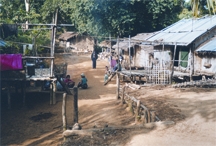Khyang
Khyang an ethnic community of the Chittagong Hill Tracts. They appear to be a faction of the ethnic community named Tame Chin of the north or Wild Chin of the south residing in the river basin of Arakan-Yoma valley. They are presumed to be migrated to Bangladesh in the 16th and 17th ecntruy. The first group of the Khyangs settled down in Muraronja mountains in Bandarban district. Their area of settlements changed from one hill to another with the change of location for jhum cultivation. At present, Khyang population in Bangladesh is between 2000-3000 only and they live in Rangamati, Bandarban and Chittagong districts.

Khyangs belong to the Kuki-Chin race of the Tibeto Brahma branch of the China-Tebetian language group. Khyangs do not have their own alphabets, although they have their own language. A single word carries different meaning with the variation of pronunciation. For example, 'Chee' means elder sister, and 'Chi' means salt or filter.
Earlier, the Khyangs were nature worshippers. In their language, the creator of the universe is 'Nahdaga'. Later, they became Buddhists. They continued to offer worship to their environmental gods and goddesses. Recently many of them have embraced Christianity. The major religious festival of the Khyang is Sanglan. The festival begins with the offering of worship for gautam buddha.

Khyangs do not marry in a same family. The marriage between paternal cousin brothers and sisters is prohibited. If any love affair develops between a pair, the guardians concerned fix the date of marriage after discussion. In the past, bridegroom had to pay dowry to the parent of the bride during marriage, which is known as 'dafa'. The rate of dafa increases if any marriage is solemnised without the consent of guardian. If a bridegroom fails to pay the dafa, his guardian brings back the bride to her parent's house. She is kept there until the dowry is paid.

Khyangs live in hut built on elevated platform. Their settlements were developed on open hilltops and near streams or fountains. They call the house 'Eem' and the village as 'Nam'. jhum cultivation is their main source of livelihood.
Khyang males wear short dress called 'Lengti' and shirt tailored by themselves. They also use ear-ring and bungles made of silver. They keep hair long and dress the hair like women. Khyang women wear lungi and blouse. They attire clothes woven by themselves. They also like to dress up themselves with variety of ornaments.
Leader of a Khyang society is called Karbari. Their society is patriarchal. Karbari disposes of any dispute or crime occur in the society in line with their own custom. Khyang people cremate corpses. [Khandkar Fatima Zahra]
